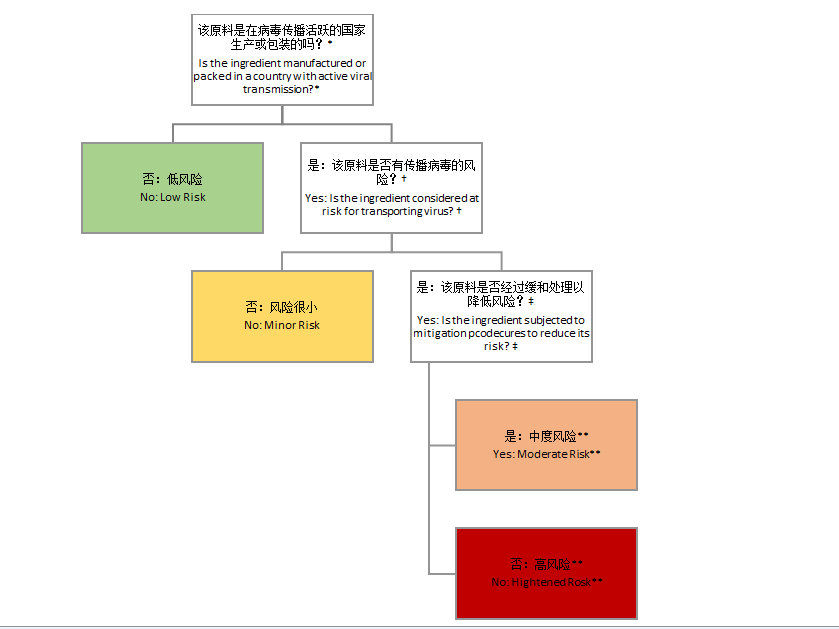
译者的话:
对于通过饲料和饲料原料传播病毒的科学研究还相对年轻,但一项研究已经证明致病性猪病毒能够在运往美国的进口饲料原料中生存,并有通过饲料原料进入美国的理论能力。研究显示可能支持病毒存活的饲料原料包括:传统豆粕、DDGS、赖氨酸盐酸盐、氯化胆碱、维生素D、猪肉肠衣、干性和湿性狗粮、有机豆粕、豆油蛋糕、湿性猫粮和猪源性原料。可能还有其他未经检测的饲料原料可以支持致病性病毒的存活。这方面的科学研究和概念证明工作仍在继续进行。
饲料原料病毒传播风险和安全性决策树
Feed Ingredient Safety Decision Tree Matrix
本信息由PorkCheckoff, 美国猪肉生产者委员会(National Pork Producer Council), 美国猪兽医协会(AASV)和美国猪健康信息中心(SHIC)联合发布。
引言 Introduction
研究已经证明,某些饲料原料在模拟的跨大西洋或跨太平洋运输到美国港口和可能生产猪饲料的地点的条件下,有支持病毒存活的能力。这增加了人们对确保饲料原料不受病毒污染的关注。下面的决策树和问题是为了帮助养猪生产者与饲料供应商合作,以把来自饲料原料的风险最小化。
Research has demonstrated the ability for certain feed ingredients to support viral survival during conditions modeled after either trans-Atlantic or trans-Pacific shipping to U.S. ports and on to locations likely to manufacture feed for swine. This has increased interest in assuring feed ingredient safety from viruses. The below decision tree and questions were developed to help pork producers work with their feed suppliers to minimize risk from feed ingredients.

把饲料原料中病毒传播风险最小化的决策树矩阵
Decision Tree Matrix to Minimize Viral Transmission Risk from Feed Ingredients
进一步降低风险的考量因素:排除,从没有活跃病毒传播的国家采购,或在接收(如果是散装)或打开包装袋(如袋装)之前采取降低风险的措施。
Considerations to further reduce risk: Consider excluding, sourcing from a country without active viral transmission, or mitigating risk prior to receiving (if bulk) or unpacking (if tote or bagged).
猪健康信息中心在www.swinehealth.org网站上维护和发布有关猪疾病矩阵的疾病监测报告,其中包括:口蹄疫病毒、经典猪瘟病毒、非洲猪瘟病毒和伪狂犬病毒。官方的国家特定疾病状况信息也可从世界动物卫生组织(OIE)网站http://www.oie.int获取。
The Swine Health Information Center maintains and publishes monitoring reports for diseases on its Swine Disease Matrix, on www.swinehealth.org, which includes: foot and mouth disease virus, classical swine fever virus, African swine fever virus, and pseudorabies virus. Official country-specific disease status is also available from the World Organization for Animal Health (OIE) at http://www.oie.int.
对于通过饲料和饲料原料传播病毒的科学研究还相对年轻,但一项研究已经证明致病性猪病毒能够在运往美国的进口饲料原料中生存,并有通过饲料原料进入美国的理论能力。研究显示可能支持病毒存活的饲料原料包括:传统豆粕1、DDGS1、赖氨酸盐酸盐1、氯化胆碱1、维生素D1、猪肉肠衣1、干性和湿性狗粮1、有机豆粕1、豆油蛋糕1、湿性猫粮1和猪源性原料2。可能还有其他未经检测的饲料原料可以支持致病性病毒的存活。这方面的科学研究和概念证明工作仍在继续进行。迄今为止,由于没有一个有组织的监测项目,在进口饲料原料中尚未发现致病性猪病毒。
The science on viral transmission through feed and feedstuffs is still relatively young, but one study has shown the theoretical ability for pathogenic swine viruses to survive transport to the United States in imported feedstuffs. The feedstuffs studied that have shown the potential to support virus survival include: conventional soybean meal1, DDGS1, lysine hydrochloride1, choline chloride1, vitamin D1, pork sausage casings1, dry and moist dog food1, organic soybean meal1, soy oil cake1, moist cat food1, and porcine-based ingredients2. There may be other feed ingredients that were not tested that could support survival of pathogenic viruses. Scientific study and proof-of-concept work in this area continues. To date, without an organized surveillance program, pathogenic swine viruses have not been identified in imported feedstuffs.
风险缓解的研究正在进行中,现有数据有限,取决于饲料原料和缓解措施,但可选方案包括:延长存储时间、辐照、热处理或化学处理(甲醛或中链脂肪酸基的液体,等等)。
Mitigation research is ongoing and available data is limited and depends upon both the ingredient and mitigation, but options may include: extended storage times, irradiation, thermal processing, or chemical treatment (formaldehyde- or medium chain fatty acid- based liquids, etc.).
在评估供应商和饲料原料安全时应考虑的问题
Discussion Points to Consider When Assessing Supplier and Feed Ingredient Safety
这些问题旨在引发关于饲料原料安全性的讨论。有些问题适用于直接饲料供应商,有些适用于饲料原料供应商。
These questions are designed to start the discussion about feed ingredient safety. Some questions will apply to producers’ immediate feed suppliers and some will apply to feed ingredient suppliers.
1.该设施(如饲料厂等)关于最大限度地减少人员、车辆和饲料原料传播病原体的生物安全计划。
Describe the facility’s biosecurity program to minimize the spread of pathogens from people, vehicles, and ingredients.
2.该设施对人员关于饲料安全的培训。
Describe the facility’s employee training on feed safety.
3.该设施的虫害控制计划。
Describe the facility’s pest control program.
4.该设施的可追溯性程序。
Describe the facility’s traceability program.
5.该设施的供应商批准程序。
Describe the facility’s supplier approval program.
6.该设施是否有第三方食品安全认证机构认证?第三方认证项目包括FAMI-QS, ISO, SQF, Safe Feed/Safe Food等。
Is the facility certified by a 3rd party certification body for food safety? Third party certification programs may include FAMI-QS, ISO, SQF, Safe Feed/Safe Food, etc.
7.该设施是否使用在美国境外生产或包装的原料?
Does the facility utilize ingredients that were manufactured or packaged outside the United States?
a)如果是,该原料是否按照食品及药物管理局(FDA)的外国供应商验证计划进口,以帮助控制风险?
If yes, was the ingredient imported following the FDA Foreign Supplier Verification Program to help control risk?
b)如果是,供应商是否考虑到猪病毒可能通过饲料原料运输的风险,如口蹄疫病毒、经典猪瘟病毒、非洲猪瘟病毒和伪狂犬病毒?
If yes, does the supplier consider the risk of swine viruses potentially transported in feed ingredients, such as foot and mouth disease virus, classical swine fever virus, African swine fever virus, and pseudorabies virus?
i.对于来自病毒风险高的国家的原料采用什么缓解策略来预防或最小化传播风险?
What mitigation strategies are used for ingredients sourced from countries of heightened viral risk to prevent or minimize risk of transmission?
ii.是否有其他可替代供应商和/或原料?
Are there alternative suppliers and/or ingredients available?
参考文献 Reference
1Dee., S., F. Bauermann, M. Niederwerder, A. Singrey, T. Clement, M. DeLima, C. Long, G. Patterson, M. Shehan, A. Stoian, V. Petrovan, C.K. Jones, J. De Jong, J. Ji., G Spronk, J. Hennings, J. Zimmerman, B. Rowland, E. Nelson, P. Sundberg, D. Diel, and L. Minion. 2018. Survival of viral pathogens in animal feed ingredients under transboundary shipping models. PLoS ONE. 13(3): e0194509. https://doi.org/10.1371/journal.pone.0194509
2Cochrane, R., S. S. Dritz, J. C. Woodworth, and C. K. Jones. 2015. Evaluating chemical mitigation of PEDv in swine feed and ingredients. J. Anim. Sci. 92(E2)090.
最新发布